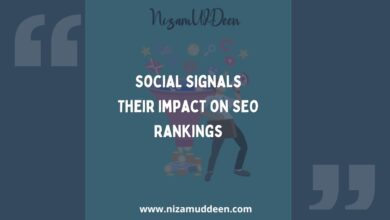Ever noticed how some websites load super fast while others make you wait?
Well, that speed isn’t just about convenience; it’s a big deal for how well a website shows up on Google and other search engines.
In simple terms, the faster a website loads, the better it is for both users and the website itself.
In this guide, we’re going to explore why the speed of a website matters so much for end user.
We’ll look at how it affects how people use a site and why Google cares about it.
We’ll also check out some easy ways websites can make sure they load quickly.
Think of it like making sure your favorite website is not just easy to use but also speedy – because in the online world, speed is a key player in SEO!
The Importance of Page Load Speed!
Ever wondered why some websites load like a breeze while others take forever?
Well, the speed at which a page loads is more than just a matter of patience—it’s a big deal for how well a website performs.
User Experience Impact
Ever left a website because it took too long to load?
No? but this is true.
That’s the user experience, and it’s a big deal when someone left your website just because the delay in loading the page.
Bounce Rates and User Engagement:
Bounce rate refers to the percentage of visitors who navigate away from a website after viewing only one page. It’s a crucial metric indicating the immediate disinterest of visitors.
Slow-loading pages often contribute to higher bounce rates. Visitors tend to leave a site if it takes too long to load, negatively impacting user engagement.
Reference relevant statistics or studies that demonstrate the correlation between page load speed and bounce rates.
Importance of First Impressions:
Discuss the psychological aspect of first impressions online. Users form opinions about a website within seconds, and page load speed plays a pivotal role in shaping these initial perceptions.
Slow-loading pages may lead users to question the credibility and professionalism of a website. You can loose trust for the most important visitor of your online business.
The importance of a positive first impression for user trust and satisfaction cannot be overstated.
Mobile Responsiveness
With more people accessing the internet on their phones, it’s crucial for websites to adapt. You should learn why being mobile-friendly is a game-changer in the digital landscape!
Growing Mobile Usage:
Provide data on the increasing prevalence of mobile device usage for internet access. Highlight the shift in user behavior towards mobile devices.
Explain how this shift necessitates websites to be optimized for mobile devices to meet user expectations.
Google’s Mobile-First Indexing:
Explain that Google predominantly uses the mobile version of the content for indexing and ranking. Mobile-friendly websites are given priority in search results.
Discuss how page load speed is a critical factor in mobile-first indexing. Slow-loading mobile pages may lead to lower search rankings.
SEO Ranking Factors Related to Page Load Speed
Ever wondered why some websites top the search results while others linger in the shadows?
Having other factors true, but we can vote few factors first.
It’s not just about keywords; it’s about how fast the pages load.
Google’s Page Experience Update
Briefly introduce Google’s Page Experience Update, emphasizing Google’s focus on delivering a positive user experience.
Explain that page load speed is a crucial component of this update, and websites are evaluated based on various user-centric metrics.
Metrics Considered:
Outline the specific metrics that Google considers in the Page Experience Update:
Largest Contentful Paint (LCP):
LCP measures the time it takes for the largest content element (e.g., an image or text block) to become visible to users.
Emphasize how a fast LCP contributes to a better user experience by ensuring that the main content is quickly accessible.
First Input Delay (FID):
FID measures the time delay between a user’s first interaction (e.g., clicking a button) and the browser’s response.
Discuss how a low FID is crucial for interactivity and engagement, as users expect prompt responses to their actions.
Cumulative Layout Shift (CLS):
CLS measures the visual stability of a page by evaluating the unexpected layout shifts during the loading process.
Explain the importance of minimizing layout shifts to prevent a disruptive user experience, especially during interactions.
Other SEO Considerations
Don’t get confused, while diving deep in SEO, you should learn how things work behind the scene.
Crawl Budget:
Provide an overview of crawl budget, which represents the number of pages a search engine will crawl on a website within a given timeframe.
Connection to Page Load Speed:
Explain how slow-loading pages can impact crawl budget negatively, as search engines may spend more time on pages with longer load times, limiting the crawling of other important pages.
Search Engine Crawling Efficiency:
Ever wondered how search engines like Google navigate and understand the vast web of information?
It’s all about efficient crawling.
Efficient Crawling:
Emphasize the importance of efficient crawling for SEO. Search engines need to quickly and effectively crawl a website to understand its content and structure.
Impact of Page Load Speed:
Discuss how fast-loading pages contribute to efficient crawling, allowing search engines to index content more promptly and comprehensively.
By understanding and optimizing for these SEO ranking factors related to page load speed, websites can align themselves with Google’s Page Experience Update and improve their overall search engine rankings.
Tools for Measuring Page Load Speed
Ever wondered how fast your favorite websites load and why some seem to zip through cyberspace?
Well, there are tools designed to unveil these speed secrets.
Google PageSpeed Insights
Overview:
Google PageSpeed Insights is a free online tool provided by Google that allows website owners to analyze the performance of their web pages.
It provides insights into various aspects of page performance, including load times, optimization suggestions, and mobile performance.
Key Features:
Google PageSpeed Insights assigns a performance score to each page, summarizing its optimization level.
How to Use:
Enter URL: Users input their website URL into the tool.
Google PageSpeed Insights then analyzes the page and generates a report with performance metrics and actionable recommendations.
GTmetrix
Overview:
GTmetrix is a web performance testing tool that provides a detailed analysis of a website’s loading speed.
It uses both Google PageSpeed and YSlow metrics to generate comprehensive insights.
Key Features:
Page Load Time: GTmetrix provides detailed information on how long it takes for a page to fully load.
Users can visualize the loading process through a waterfall chart, identifying elements causing delays.
GTmetrix stores historical data, allowing users to track changes in page performance over time.
How to Use:
Enter URL: Users enter the URL they want to analyze.
The tool generates a report with detailed performance metrics, scores, and recommendations for improvement.
Pingdom
Overview:
Pingdom is a website monitoring service that includes a page speed testing feature.
It measures the load time of a webpage and provides insights into performance bottlenecks.
Key Features:
Pingdom assigns a performance grade to the website based on various factors, providing a quick overview of its performance.
Users can see a detailed breakdown of the components contributing to the overall load time.
Pingdom offers additional features for ongoing website monitoring, including alerts for downtime and performance issues.
How to Use:
Enter URL: Users input the URL they want to test.
Pingdom generates a report with performance insights, including load times, grade, and recommendations for improvement.
These tools are invaluable for website owners and developers aiming to optimize page load speed.
Strategies for Improving Page Load Speed
Image Optimization
Overview:
Images are often a significant contributor to page load times. Optimizing images helps reduce file sizes without compromising quality, resulting in faster load times.
Optimization Techniques:
Use image compression tools to reduce the file size of images. This reduces the amount of data that needs to be transferred, speeding up the loading process.
Choose appropriate image formats (e.g., JPEG, PNG, WebP) based on the content. WebP, for example, is known for its high compression efficiency.
Responsive Images:
Implement responsive image techniques to serve different image sizes based on the user’s device. This prevents unnecessary loading of large images on smaller screens.
Minimizing HTTP Requests
Overview:
Each element on a webpage (e.g., images, stylesheets, scripts) requires a separate HTTP request. The more requests, the longer the page takes to load.
Optimization Techniques:
Reduce the number of separate files by combining CSS and JavaScript files. This minimizes the total number of HTTP requests, improving load times.
Combine multiple small images into a single sprite sheet to reduce the number of individual image requests.
Browser Caching
Overview:
Browser caching involves storing static files locally on a user’s device. When a user revisits a page, these files can be retrieved from the local cache instead of re-downloading.
Optimization Techniques:
Configure the server to include proper cache headers, specifying how long browsers should cache specific files. This reduces the need for repeated downloads.
Use file versioning (e.g., appending a version number to filenames) to force browsers to fetch the latest version when changes are made.
Content Delivery Network (CDN) Integration
Overview:
Content Delivery Networks distribute website content across a network of servers globally. This reduces the physical distance between the user and the server, resulting in faster load times.
Optimization Techniques:
Utilize a CDN to store and deliver static assets (e.g., images, stylesheets) from servers located strategically around the world.
Leverage CDN edge servers for caching to deliver frequently requested content quickly.
Considerations:
Evaluate the cost and configuration aspects of integrating a CDN. Choose a CDN provider that aligns with the website’s needs and user base.
By implementing these strategies, website owners and developers can significantly improve page load speed, providing a better user experience and positively impacting SEO rankings.
Conclusion
In summary, the connection between page load speed and SEO is crucial for online success. Slow-loading pages not only affect user experience but also impact search engine rankings. The importance of speed is evident in the context of mobile usage and Google’s Mobile-First Indexing.
Exploring SEO ranking factors, we’ve covered Google’s Page Experience Update and metrics like LCP, FID, and CLS, emphasizing a comprehensive approach to modern SEO. Tools like Google PageSpeed Insights, GTmetrix, and Pingdom offer actionable insights for website optimization.
Strategies for faster load times, such as image optimization, reducing HTTP requests, using browser caching, and integrating CDNs, provide practical steps for webmasters to enhance user experience and SEO.
In a fast-paced digital world, prioritizing page load speed is an investment in competitiveness. By implementing these insights and strategies, website owners can navigate the digital landscape with speed and efficiency, ensuring their content is not only discovered but delivered swiftly for a positive user experience and improved search rankings.



